Abstract
Inhibition by isoprenaline of the aggregatory response of human and rat platelets induced by various excitatory agonists is blocked by beta 2-adrenoceptor antagonists. beta 1-Adrenoceptor antagonists are ineffective. beta 2-Adrenoceptor agonists cause inhibition of the response of human platelets to various excitatory agonists. The maximal extent of inhibition is less than that observed for isoprenaline. beta 1-Adrenoceptor agonists fail to cause detectable inhibition of this response. Neither beta 1 nor beta 2-adrenoceptor agonists cause inhibition of the response of rat platelets to excitatory agonists. Only beta 2-adrenoceptor agonists block the inhibitory response to isoprenaline. The extent of inhibition by isoprenaline is a function of the excitatory agonist used and in human platelets is correlated with the ability of that agonist to suppress elevated platelet cyclic adenosine 3',5'-monophosphate (cyclic AMP) levels. Inhibition by isoprenaline is prevented in the presence of an inhibitor of adenylate cyclase. Isoprenaline increases platelet cyclic AMP levels with an EC50 similar to that required to observe inhibition of the aggregatory response. These data indicate that human platelets carry beta 2-adrenoceptors whose occupancy causes inhibition of the response to excitatory agonists as a consequence of elevation of platelet cyclic AMP. The beta-adrenoceptor present on rat platelets also appears to be of the beta 2-subtype.
Full text
PDF
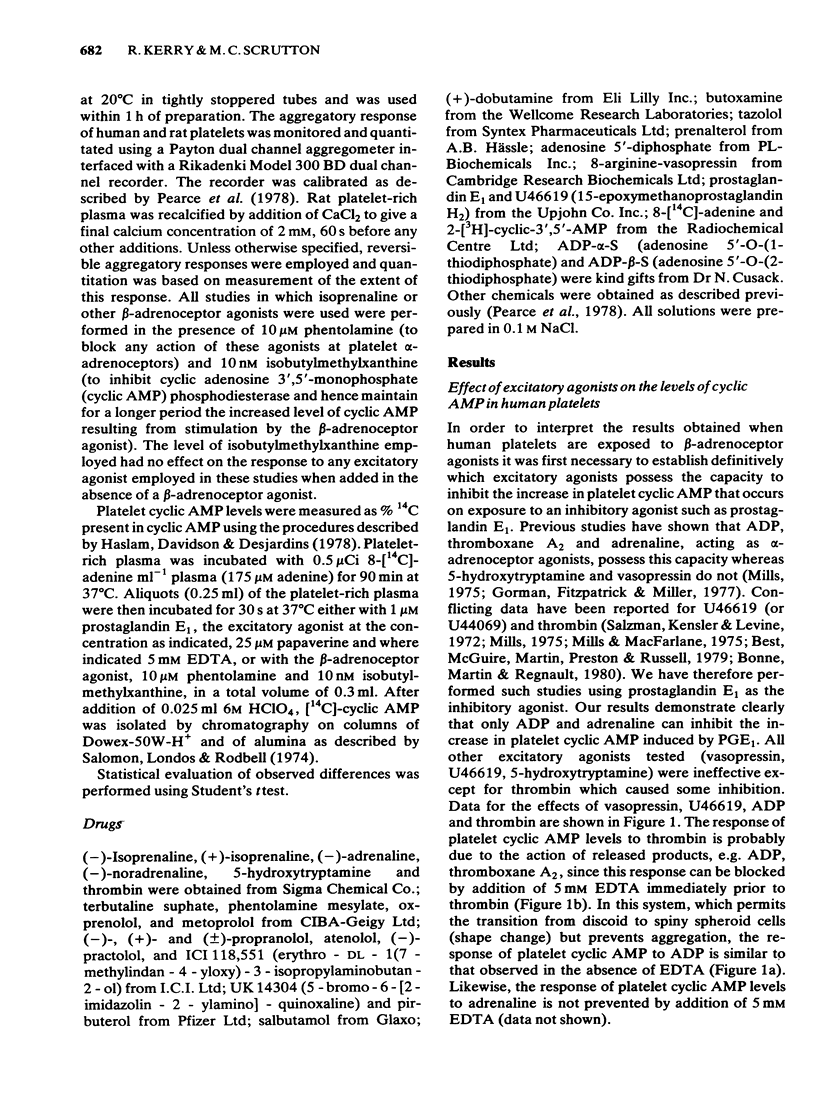
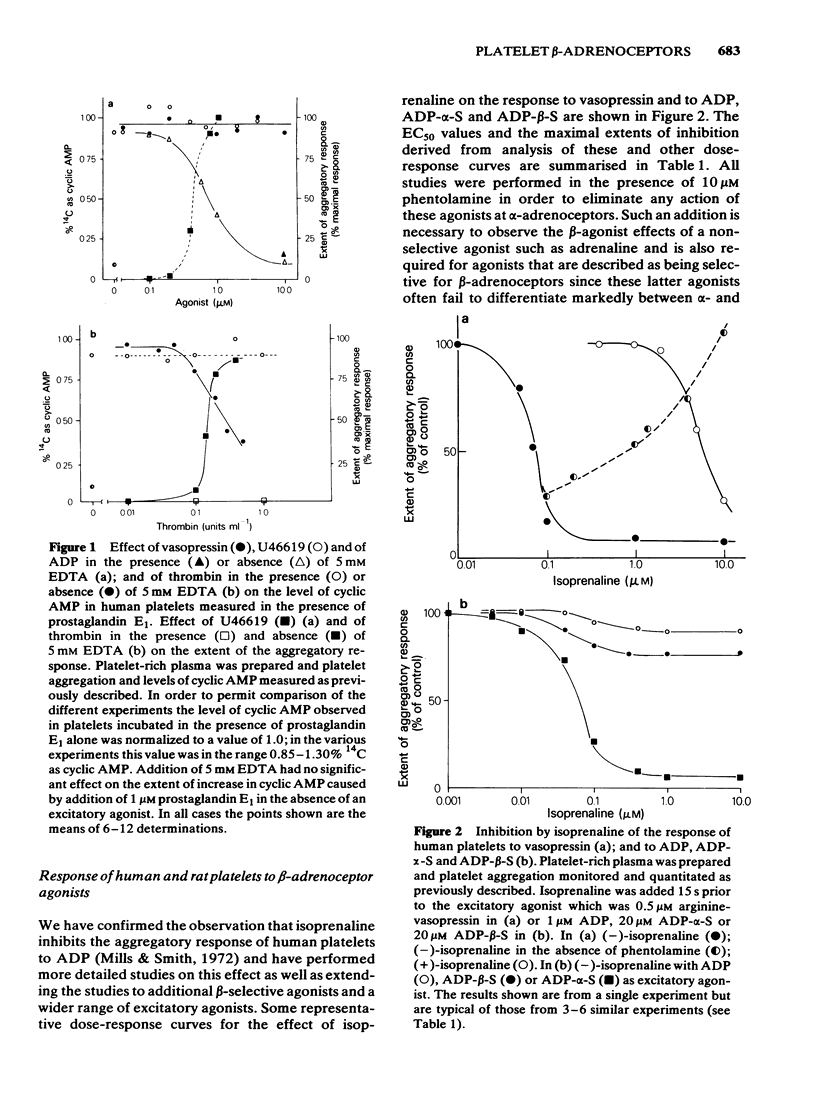

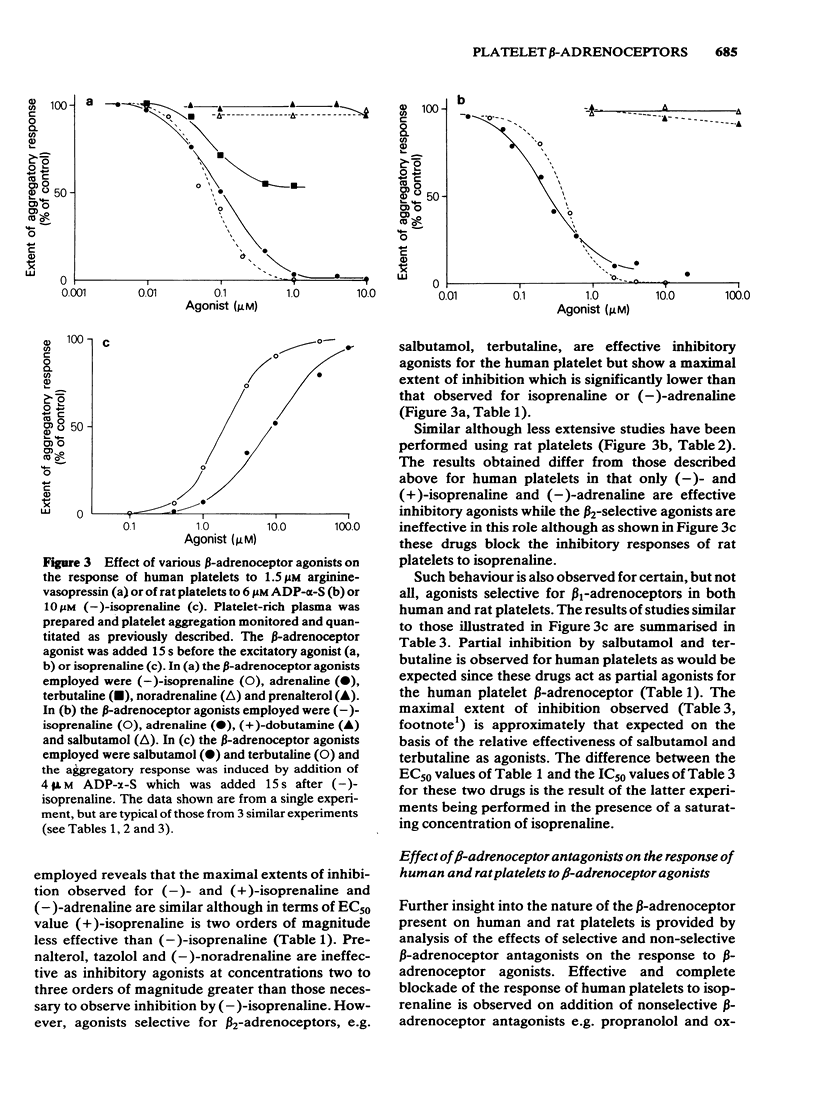

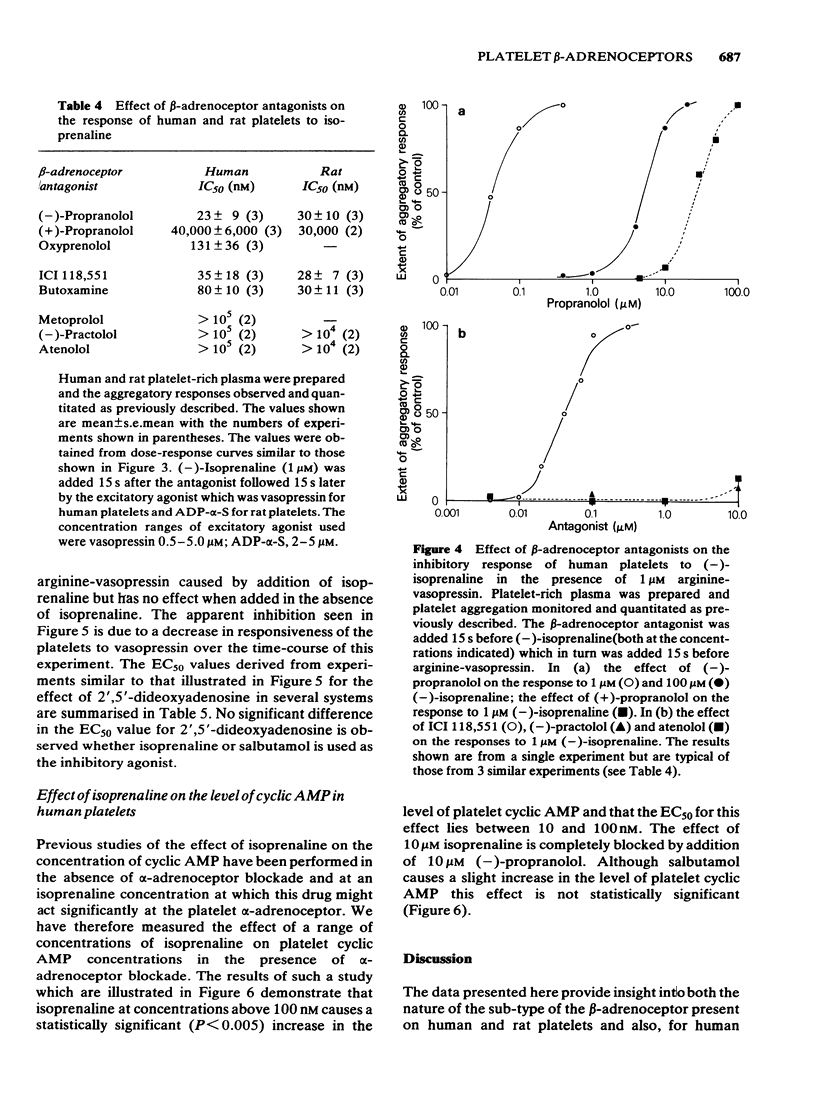
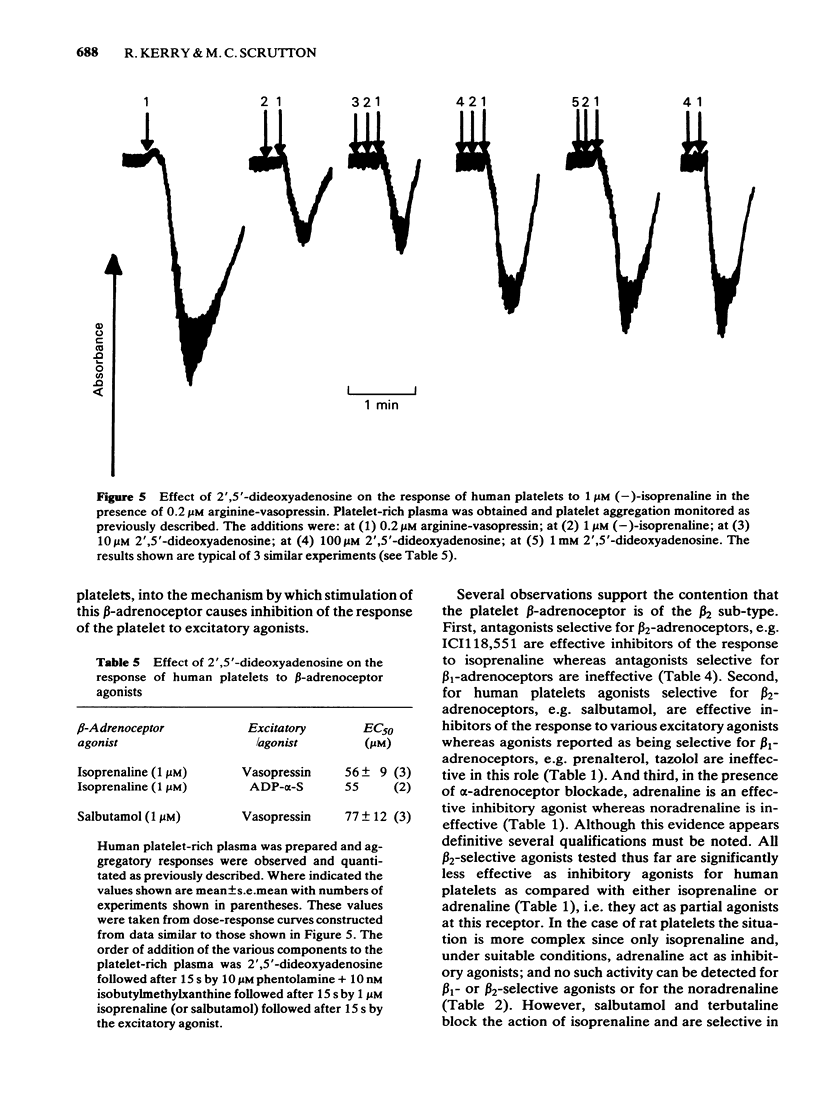
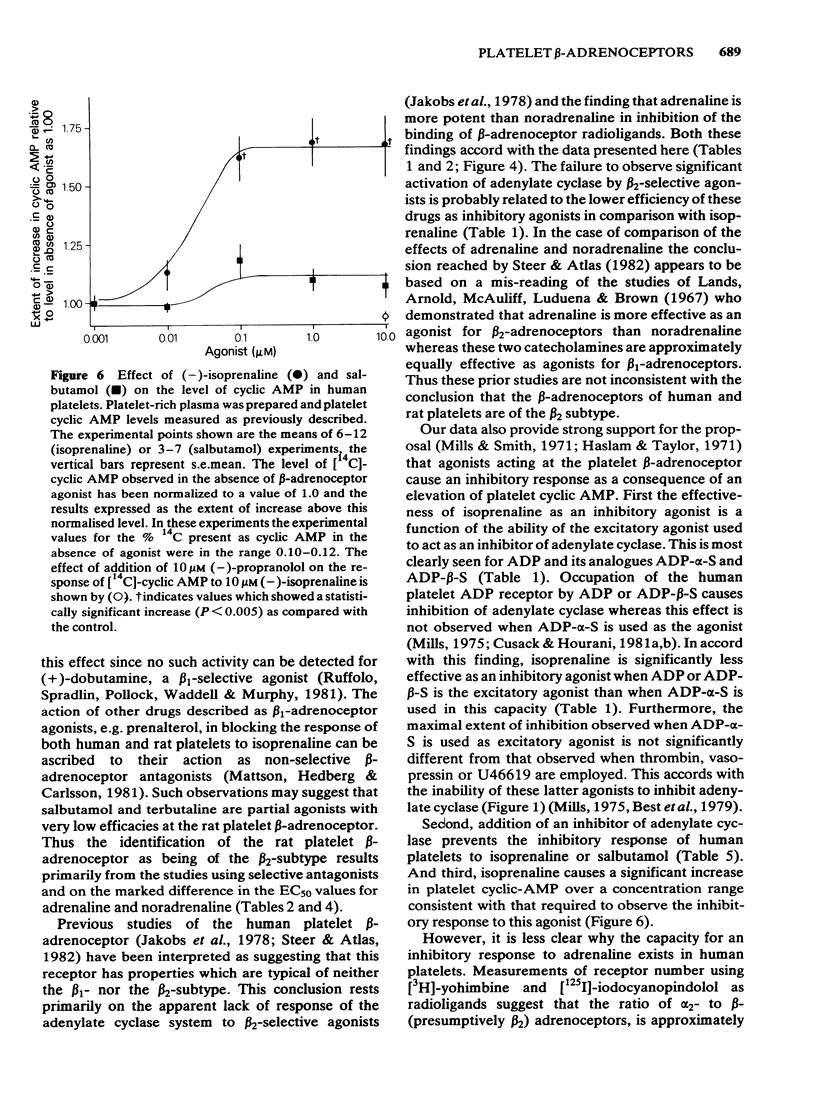
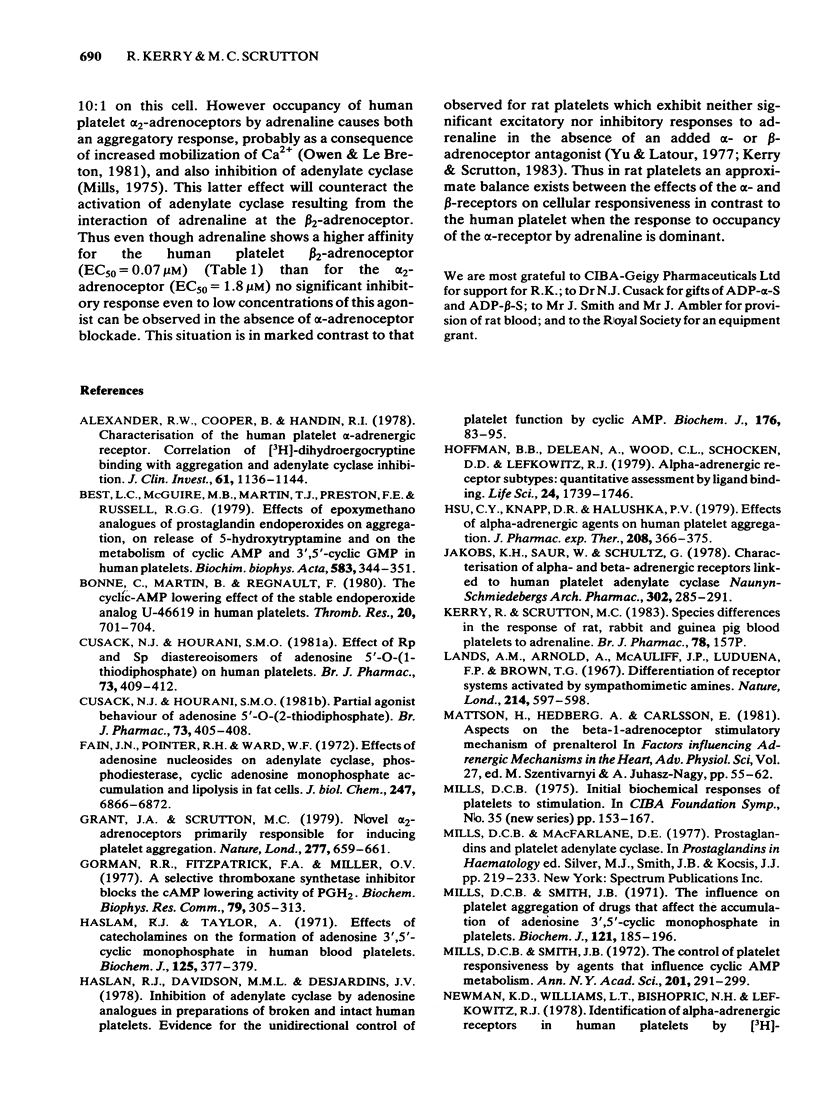

Selected References
These references are in PubMed. This may not be the complete list of references from this article.
- Alexander R. W., Cooper B., Handin R. I. Characterization of the human platelet alpha-adrenergic receptor. Correlation of [3H]dihydroergocryptine binding with aggregation and adenylate cyclase inhibition. J Clin Invest. 1978 May;61(5):1136–1144. doi: 10.1172/JCI109028. [DOI] [PMC free article] [PubMed] [Google Scholar]
- Best L. C., McGuire M. B., Martin T. J., Preston F. E., Russell R. G. Effects of epoxymethano analogues of prostaglandin endoperoxides on aggregation, on release of 5-hydroxytryptamine and on the metabolism of 3',5'-cyclic AMP and cyclic GMP in human platelets. Biochim Biophys Acta. 1979 Mar 22;583(3):344–351. doi: 10.1016/0304-4165(79)90458-6. [DOI] [PubMed] [Google Scholar]
- Bonne C., Martin B., Regnault F. The cyclic AMP-lowering effect on the stable endoperoxide analog U46619 in human platelets. Thromb Res. 1980 Dec 1;20(5-6):701–704. doi: 10.1016/0049-3848(80)90159-0. [DOI] [PubMed] [Google Scholar]
- Cusack N. J., Hourani S. M. Effects of RP and SP diastereoisomers of adenosine 5'-O-(1-thiodiphosphate) on human platelets. Br J Pharmacol. 1981 Jun;73(2):409–412. doi: 10.1111/j.1476-5381.1981.tb10437.x. [DOI] [PMC free article] [PubMed] [Google Scholar]
- Cusack N. J., Hourani S. M. Partial agonist behaviour of adenosine 5'-O-(2-thiodiphosphate) on human platelets. Br J Pharmacol. 1981 Jun;73(2):405–408. doi: 10.1111/j.1476-5381.1981.tb10436.x. [DOI] [PMC free article] [PubMed] [Google Scholar]
- Fain J. N., Pointer R. H., Ward W. F. Effects of adenosine nucleosides on adenylate cyclase, phosphodiesterase, cyclic adenosine monophosphate accumulation, and lipolysis in fat cells. J Biol Chem. 1972 Nov 10;247(21):6866–6872. [PubMed] [Google Scholar]
- Gorman R. R., Fitzpatrick F. A., Miller O. V. A selective thromboxane synthetase inhibitor blocks the cAMP lowering activity of PGH2. Biochem Biophys Res Commun. 1977 Nov 7;79(1):305–313. doi: 10.1016/0006-291x(77)90096-1. [DOI] [PubMed] [Google Scholar]
- Grant J. A., Scrutton M. C. Novel alpha2-adrenoreceptors primarily responsible for inducing human platelet aggregation. Nature. 1979 Feb 22;277(5698):659–661. doi: 10.1038/277659a0. [DOI] [PubMed] [Google Scholar]
- Haslam R. J., Davidson M. M., Desjardins J. V. Inhibition of adenylate cyclase by adenosine analogues in preparations of broken and intact human platelets. Evidence for the unidirectional control of platelet function by cyclic AMP. Biochem J. 1978 Oct 15;176(1):83–95. doi: 10.1042/bj1760083. [DOI] [PMC free article] [PubMed] [Google Scholar]
- Haslam R. J., Taylor A. Effects of catecholamines on the formation of adenosine 3':5'-cyclic monophosphate in human blood platelets. Biochem J. 1971 Nov;125(1):377–379. doi: 10.1042/bj1250377. [DOI] [PMC free article] [PubMed] [Google Scholar]
- Hoffman B. B., De Lean A., Wood C. L., Schocken D. D., Lefkowitz R. J. Alpha-adrenergic receptor subtypes: quantitative assessment by ligand binding. Life Sci. 1979 May 7;24(19):1739–1745. doi: 10.1016/0024-3205(79)90061-4. [DOI] [PubMed] [Google Scholar]
- Hsu C. Y., Knapp D. R., Halushka P. V. The effects of alpha adrenergic agents on human platelet aggregation. J Pharmacol Exp Ther. 1979 Mar;208(3):366–370. [PubMed] [Google Scholar]
- Jakobs K. H., Saur W., Schultz G. Characterization of alpha- and beta-adrenergic receptors linked to human platelet adenylate cyclase. Naunyn Schmiedebergs Arch Pharmacol. 1978 May;302(3):285–291. doi: 10.1007/BF00508297. [DOI] [PubMed] [Google Scholar]
- Lands A. M., Arnold A., McAuliff J. P., Luduena F. P., Brown T. G., Jr Differentiation of receptor systems activated by sympathomimetic amines. Nature. 1967 May 6;214(5088):597–598. doi: 10.1038/214597a0. [DOI] [PubMed] [Google Scholar]
- Mills D. C. Initial biochemical responses of platelets to stimulation. Ciba Found Symp. 1975;35:153–173. doi: 10.1002/9780470720172.ch8. [DOI] [PubMed] [Google Scholar]
- Mills D. C., Smith J. B. The influence on platelet aggregation of drugs that affect the accumulation of adenosine 3':5'-cyclic monophosphate in platelets. Biochem J. 1971 Jan;121(2):185–196. doi: 10.1042/bj1210185. [DOI] [PMC free article] [PubMed] [Google Scholar]
- Newman K. D., Williams L. T., Bishopric N. H., Lefkowitz R. J. Identification of alpha-adrenergic receptors in human platelets by [3H]dihydroergocryptine binding. J Clin Invest. 1978 Feb;61(2):395–402. doi: 10.1172/JCI108950. [DOI] [PMC free article] [PubMed] [Google Scholar]
- O'BRIEN J. R. A COMPARISON OF PLATELET AGGREGATION PRODUCED BY SEVEN COMPOUNDS AND A COMPARISON OF THEIR INHIBITORS. J Clin Pathol. 1964 May;17:275–281. doi: 10.1136/jcp.17.3.275. [DOI] [PMC free article] [PubMed] [Google Scholar]
- Pearce P. H., Wright J. M., Egan C. M., Scrutton M. C. Interaction of human blood platelets with the 2',3'-dialdehyde and 2',3'-dialcohol derivatives of adenosine 5'-diphosphate and adenosine 5'-triphosphate. Eur J Biochem. 1978 Aug 1;88(2):543–554. doi: 10.1111/j.1432-1033.1978.tb12480.x. [DOI] [PubMed] [Google Scholar]
- Ruffolo R. R., Jr, Spradlin T. A., Pollock G. D., Waddell J. E., Murphy P. J. Alpha and beta adrenergic effects of the stereoisomers of dobutamine. J Pharmacol Exp Ther. 1981 Nov;219(2):447–452. [PubMed] [Google Scholar]
- Salomon Y., Londos C., Rodbell M. A highly sensitive adenylate cyclase assay. Anal Biochem. 1974 Apr;58(2):541–548. doi: 10.1016/0003-2697(74)90222-x. [DOI] [PubMed] [Google Scholar]
- Salzman E. W., Kensler P. C., Levine L. Cyclic 3',5'-adenosine monophosphate in human blood platelets. IV. Regulatory role of cyclic amp in platelet function. Ann N Y Acad Sci. 1972 Oct 27;201:61–71. doi: 10.1111/j.1749-6632.1972.tb16287.x. [DOI] [PubMed] [Google Scholar]
- Steer M. L., Atlas D. Demonstration of human platelet beta-adrenergic receptors using 125I-labeled cyanopindolol and 125I-labeled hydroxybenzylpindolol. Biochim Biophys Acta. 1982 Apr 7;686(2):240–244. doi: 10.1016/0005-2736(82)90118-3. [DOI] [PubMed] [Google Scholar]
- Yu S. K., Latour J. G. Potentiation by alpha and inhibition by beta-adrenergic stimulations of rat platelet aggregation. A comparative study with human and rabbit platelets. Thromb Haemost. 1977 Jun 30;37(3):413–422. [PubMed] [Google Scholar]


